Why not link to the original?
- 5 Posts
- 49 Comments

 46·27 days ago
46·27 days agoAlso a housing bubble and real estate being one of the few investment vehicles available to regular chinese.

 2·1 month ago
2·1 month agoYou misunderstand, the first two commands are just one time setup to install a specific python version and then to create an env using that version. After that all you need is `pyenv activate myenv´ to drop you into that env, which will use the correct python version and make sure everything is isolated from other environments you might have.
You can also just create an env with the system python version, but the question was specifically about managing multiple versions of python side by side and this makes that super easy.
You could also combine it with
direnvto automatically drop you into the correct environment based on the folder you are in, so you don’t have to type anything after the initial setup.
But a lot of european countries are pushing pretty hard to not borrow and have a zero balance or positive budget. So e.g. Switzerland don’t sell that many bonds and yield on a lot of them is 0.5%, maybe 2% on long term ones vs around 4% for US ones.

 101·1 month ago
101·1 month agopyenv and pyenv-virtualenv together solves this for me. Virtualenv with specific python versions that work together well with other tools like pip or poetry.
It boils down to something like
$ pyenv install 3.12.7 $ pyenv virtualenv 3.12.7 myenv $ pyenv activate myenvand at that point you can do regular python stuff like pip installing etc.

 4·1 month ago
4·1 month agoIn addition to all the other comments, pumping warm water into natural bodies of water can also be bad for the environment.
i know of one nuclear powerplant that does this and it’s pretty bad for the coral population there.

 1·1 month ago
1·1 month agoYou could give helix a try, feature/functionality wise it’s almost vim, but with 0 config needed and all commands easily discoverable which is closer to nano.
As someone who really tried to get into modal editors, both emacs and vim, for years, it was the first one where i was reasonably fast after a short time and it was easy to discover the keybindings.

 9·2 months ago
9·2 months agoIt’s the most common communication tool for friends and family in much of europe

 71·2 months ago
71·2 months agoSlavery in the US before the civil war didn’t happen in a vacuum. There were slaves in the south that didn’t consume anything, producing goods that in a large part were exported to britain. And the money from that was used to buy more slaves and land. But some of it was used to buy goods and expertise from the north that the slave economy was lacking, which in turn drove industrialization in the north.
But i stand by my point that over time the artificially low prices due to slave labor causes outflows of money from the rest of the world, depriving workers in other countries of money/wages and causing them to spend less. So all those slaves would overproduce things that there isn’t demand anymore and it’s still worse for the rich fucks than if they had paid slaves a fair wages.
Just to be clear, I’m not saying such a system can’t exist or work, just that in the long run it’s worse for everyone, even the rich who thrive on exploiting poor people.
Sadly the billionaire class don’t seem to understand this and there’s not much to do other than teaching them by force every 50-150 years.

 311·2 months ago
311·2 months agoWell, profitable in the short term. If the lowly peons don’t have money because you took it all, they cant spend it on stuff from your factories and your profit goes down and everything grinds to a halt. of course you can try to sell it to other countries, which fucks over their economies and makes them more susceptible to populism/facism (well after an initial phase of excitement over those sweet cheap imports) and then it’s facism all around and everyone is fucked. You just need to plan it well enough so you’re on your private island/mars colony with robot butlers by that point

 9·2 months ago
9·2 months agoAnd keep the old pieces, in the end assemble them back together and see what the differences are

 71·2 months ago
71·2 months ago‘Programming from the ground up’ the main idea of this one is to teach programming in a bottom up way, so very low level.
it’s mostly about teaching (linux) assembly to beginners, so in a way it is just learning a new language. But it’s mainly about understanding low level how a computer works, like registers, kernel calls, how function calls are handled, all for beginners. It’s really easy to pick up.
Knowing those fundamentals can go a long way in understanding other computing concepts.
Others that come to mind are :
- Designing Data-Intensive Applications: The Big Ideas Behind Reliable, Scalable, and Maintainable Systems
- A Philosophy of Software Design
- Software Architecture: The Hard Parts"

 5·2 months ago
5·2 months agoI love my Glove80, had it for about a year now and couldn’t be happier.
For anyone interested in alt layouts, https://getreuer.info/posts/keyboards/alt-layouts/index.html is one of the best introductions out there. Also https://lemmy.world/c/ergomechkeyboards is a nice resource on fancy keyboards.

 8·2 months ago
8·2 months agoThere was a recent paper that argues ‘bullshitting’ is the most apt analogy. I.e. telling something to satisfy the other person without caring about the truth content of what you say

 44·2 months ago
44·2 months agoAdding a copilot button to a laptop, 10 years jail

 25·2 months ago
25·2 months agoNot necessarily, as I understand, the floor price is just theld buy one at. i could make a new nft, list it at 500 billion and that would be the floor price, even if no trade ever happens.
There’s also some stuff where the nfts get used as collateral for loans without any intention to pay back the loan. The borrower defaults, keeps the money, the lender is stuck with a useless nft. No actual sale happened, so the floor price didn’t move, even though the loan was likely for less than the floor price.
Crypto is full of this kind of misleading metrics, same as market cap

 1·2 months ago
1·2 months agoWell, cars are certainly important everywhere in the world and still too important in Switzerland. But relatively speaking compared to other countries they’re really not that important.
Right now there’s a vote coming up to build more highways, it’ll be interesting to see how that turns out.
To put some numbers on things, we spend 4-5 billion per year on rail, we spend 8.8billion over the next 3 years on road maintenance plus total another 11 billion until 2030 for new road infrastructure. I wouldn’t call that ‘barely investing’, it seems roughly equal to me.

 1·3 months ago
1·3 months agoWait, this makes it sound like you were doing it by hand? There’s quite a few tools to do that for you, e.g. https://github.com/j0be/PowerDeleteSuite

 22·3 months ago
22·3 months agoI always thought the Mer de Glace at the Mont Blanc illustrates this really well. You arrive and there’s a sign “the glacier was here in 1910” and that’s where tourists back then.
To get to the actual glacier, you have to eall down many flights of metal stairs for about half an hour and there’s several signs for different years, 1950, 1990, 2002, 2006, 2009, 2012, 2014, 2015, something like this, with the years between each sign getting shorter but the distance staying roughly the same. And from the top it’s really far away.
Of course, once you actually reach the glacier, you get to the main attraction, a 3m diameter tunnel they bored 100m deep into it as a tourist attraction with ice sculptures inside. Above the tunnel you can see the remains of the tunnel from the previous year, half melted…




I’m super happy with Kagi search. Even the AI summary is quite good as it’s based on the search results, not just made up from training data. Of course, it’s still a stupid LLM, so double check everthing. But i find it quite useful to get a grasp on the overall content of the results.
And search itself works well, haven’t had a moment where it was worse than one of the big providers. The dedicated forum, programming and other serchas are cool and i love being able to adjust the priority of pages or even blacklist them.